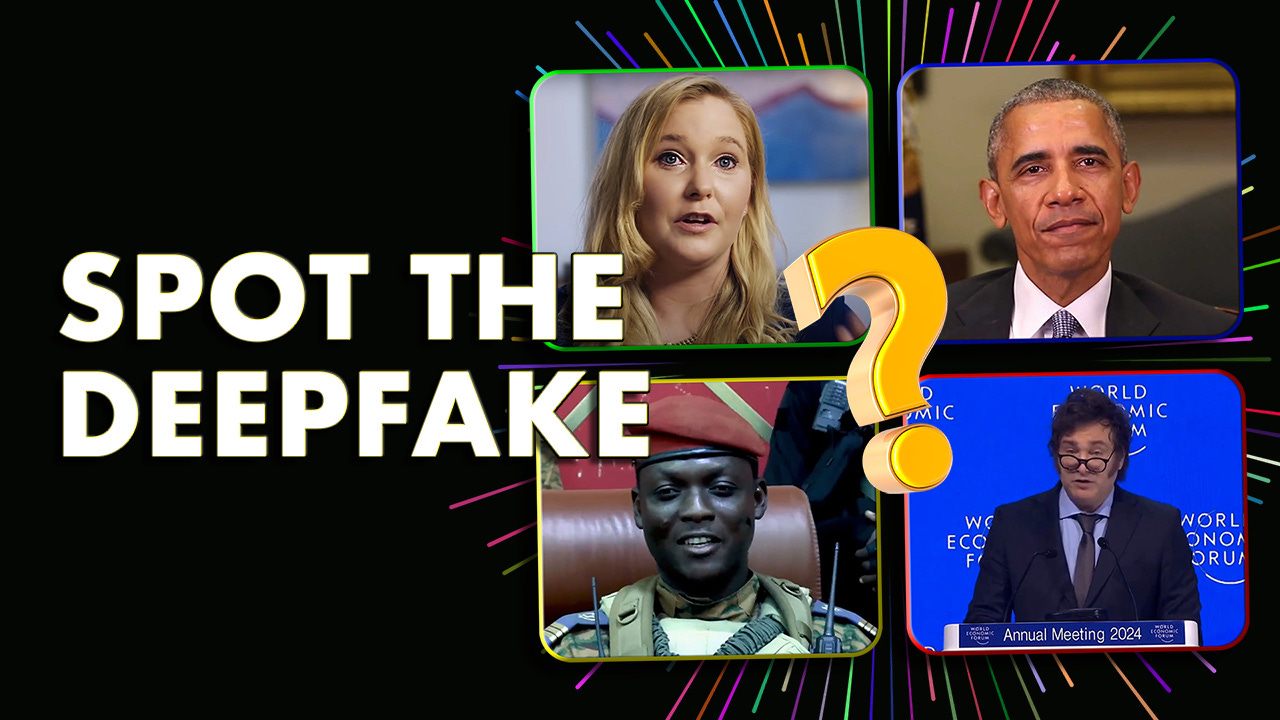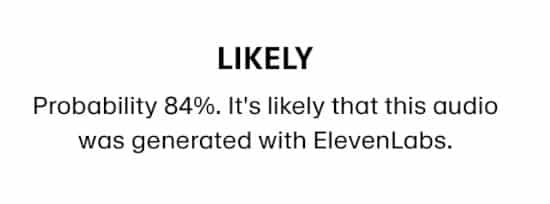by James Corbett
corbettreport.com
June 29, 2025
Do you remember back in 2018 when Buzzfeed introduced the world to the concept of the "deepfake" in the most dramatic way possible?
Jordan Peele's mouth on Barack Obama's face? The "FakeApp" software? The pat reassurance that "all it takes [to spot a deepfake] is a bit of patience and skepticism"? In retrospect, everything about Buzzfeed's deepfake warning seems quaint.
Silly as it may have been, however—it took 56 hours of video processing and the oversight of a video effects professional to put together that rather unconvincing video, we were told—the warning itself was an apt one. As it turns out, Buzzfeed was correct to alert us to the fact that convincing deepfake videos "will get easier, cheaper, and more ubiquitous faster than you would expect" and that "an age of ubiquitous deepfakes could help usher in an 'infocalypse.'"
Still not worried? You should be. I'm willing to bet that you've already been fooled by a deepfake video at some point, and the future is likely to be one in which no digital image, video or audio file can be taken at face value.
Don't believe me? Then I invite you to take the following test . . .
The Challenge
Let's look at three recent videos. Your task is to tell me which of these videos are real and which are AI-generated fakes. Are you ready?
Here's the first video:
And here's the second:
And here's the third:
OK, no cheating now. Without reading ahead, tell me which of these videos you think are real and which are AI-generated fakes.
Go on, I'll wait for you to log in to corbettreport.com and leave your guess in the comments section of this post over there. . . .
. . . OK, that should be enough time.
So, have you made your guesses? Great! So have I!
And do you want to know the correct answer? Great! So do I!
The Results
As you may or may not know, the first video is purported to be a clip of Burkina Faso President Ibrahim Traoré delivering a speech in English. The video is labeled a "speech to the IMF," and if your "FAKE VIDEO!" alarm bells are not ringing after watching the video for longer than ten seconds then you might need to replace the batteries in your "FAKE VIDEO!" alarm.
Throughout the entirety of the nearly 30-minute-long video, Traoré makes the same left-to-right-to-left-to-right head movement over and over and over and over and over and over and over and over and over and over. (Seriously, scroll through the full video to see how utterly ridiculous this is.)
The microphone in front of his face keeps halfway disappearing.
And the audience behind him keeps dissolving into a strange, beatific light before rematerializing (evidently none the worse for wear).
And, of course, it's difficult not to notice the strange, clipped quality of Traoré's vocal delivery, with some sentences suddenly stopping in an unnatural-sounding way.
Now, once these things are pointed out to you, you will realize that something is "off" here. But this clearly doctored video has been posted in numerous places online as a supposedly real speech and was even forwarded to me by a well-meaning listener who earnestly observed that "I haven't heard this courage, clarity, and insight from an African leader for a long time."
A cursory search will reveal that there is no reputable news outlet or independent source of any kind that has recorded this earth-shattering speech or any transcript or quote from it. The only place it shows up is on random YouTube channels and obscure Facebook posts.
In short, this is clearly a fake video of some sort, although further research would be necessary to determine the exact provenance of this doctored speech.
So, how about the second video?
This video purports to convey the audio of Virginia Giuffre's "dead man's switch" message. As my knowledgeable readers no doubt know, Virginia Giuffre was one of the most well-known of Jeffrey Epstein's victims, and—as I discussed with veteran Epstein researcher and author Nick Bryant—she committed suicide (or "committed suicide," depending what you believe) this past April. The audio from the video is supposedly a message she recorded that was to be automatically released upon her death and which would reveal all the things she was unable to say while alive.
Undoubtedly, the information this audio message conveys is shocking: Epstein is alive. High-profile visitors to Epstein's "pedophile island" included Barack Obama and George Clooney and Tom Hanks. Bill Gates performed sickening genetic experiments on children there.
But is the message real? Does that voice sound like an authentic human voice to you, or a computer-generated AI deepfake?
There's little doubt in my mind that this is not an authentic human voice, but if it sounds like one to you, what could I possibly say to persuade you it isn't? What could you possibly say to convince me it is?
There's forensic analysis, of course . . . but "forensic analysis" in this case means running it through a so-called "AI voice detector" on some sketchy website or other using some "AI voice detecting" process that is completely opaque and is itself dependent on AI technology. Rather than answering the question of whether a voice is authentically human or AI-generated, these "deepfake detectors" only add another layer of uncertainty to the debate.
For what it's worth, "AI Voice Sensor" indicates this audio is "100% likely to be a genuine human voice" (I like those odds!):
ElevenLabs' "AI Speech Classifier," on the other hand, rates the audio clip 84% likely to have been generated with ElevenLabs' AI audio tools:
In other words, whatever you want to believe about this audio, you can now point to a supposedly objective analysis confirming your intuition! Great!
Alright, then, how about the third video? Can we determine if this one is real or fake?
Thankfully, we have finally found a video whose authenticity (or lack thereof) is not in dispute!
This is the speech that Argentinian President Javier Milei delivered at the World Economic Forum's Annual Meeting at Davos in January 2024. Here's the video of the actual speech: "La conferencia completa de Javier Milei En Davos."
The speech was rendered into English by Heygen, an AI video generator that offers AI translation capabilities. Heygen doesn't just translate the words of any given speaker in any given video. It doesn't merely generate an AI voice saying those translated words. It renders that voice in the style of the speakers' voice and then automatically lip syncs the video to the AI-generated voice.
In other words, you are watching Milei's Spanish speech in English as if it were delivered by Javier Milei himself in English.
It isn't hard to see why this technology blew people's minds at the time, with the video receiving millions of views online and generating numerous headlines. After all, this technology has the potential to truly eliminate the language barrier between human beings once and for all . . . provided they are communicating with each other through the appropriate technology, of course.
Pandora's box has been opened. But what does it mean?
What It Means
It doesn't take a great deal of imagination to see how this type of AI-deepfake-voice-clone/auto-translate/lip-sync technology could lead to some remarkable breakthroughs and change the world for the better.
In "AI just changed the world. Again," Sean Thomas of The Spectator explores how this technology could be used to transform our world in the near future:
Presumably, this software will soon be linked to glasses, or lenses, which will execute this task [translation and lip syncing] automatically, and all you will have to do, in Pisa, Lima, or Osaka, is wear these glasses and you will understand what everyone is saying, and read all their facial language, almost like you were born there. We could call these glasses Babel Glasses, in honour of Douglas Adams' instant universal translator, the Babel Fish, because there is a striking similarity. The main difference is that Babel Glasses will be much better than the Babel Fish, because of the lip syncing.
On the other hand, it doesn't take a great deal of imagination to see how this technology could be used to undermine the fabric of trust upon which our civilization is built.
Did Virginia Giuffre kill herself, or was she murdered? Did she record a last message testifying to all the blockbuster information she didn't reveal while she was alive? Has that recording been obtained and accurately conveyed by a single news site by means that have not yet been revealed?
The answers to these questions are, needless to say, incredibly important and potentially politically explosive. But now imagine the question of the authenticity of an audio or video file becoming the norm for every explosive piece of audio or video that is reported from now on.
To put it another way, imagine a world where everyone is not only forced to scrutinize the political slant of this or that particular reporter or to ponder what information might have been omitted in a report but is also compelled to question every single audio or video statement and every single document of every single event that is ever reported in the future.
That is the world we're about to be plunged into.
And, as bad as things are, they're getting worse by the day. Corbett Reporteers will already have been exposed to Veo3, the latest AI video generation model that was used to produce the hyper-realistic videos that opened my recent podcast, "We Need To Talk About AI." Given how quickly AI text-to-video generation has progressed in the past three years alone, it is almost certain that AI-generated video will be completely indistinguishable from real life in a few short years.
Imagine the potential future release of Epstein blackmail footage, then. No matter how damning that footage is for whatever politician, businessman or financier is depicted in that footage, they will now have the plausible excuse that it is AI-generated footage. Of course they would never do such a thing, and how dare you for taking such evidence at face value!
The accused's supporters will be happy to go along with this excuse, of course, and exonerate him of any crime. His detractors will refuse to believe that the footage isn't real. Various "deepfake detection" technologies will be employed, likely giving contradictory results, as in the Giuffre example above.
Now, people will not be squabbling over the interpretation of facts. They will not be contesting ideologies or world views. They will be facing off over the documentation of reality itself. What happened, and how can we ever prove that it happened?
And this is not likely to be the way that one or two high-profile scandals play out in the future. Every event of significance will now come with reporters carrying the extra burden of proving it ever took place at all.
We are officially losing our grasp of the concept of reality itself.
The Solution?
What, then, is the solution to this sticky situation?
As usual, governments are stepping in to try to "fix" the situation. . . . And, as usual, this government "fix" does not mean "to repair" or "to improve" but "to rig."
For one example, a bill working its way through the US Senate is known as the "NO FAKES Act of 2025." According to a press release from one of the congress critters co-sponsoring the bill, the NO FAKES Act "protects the voice and likeness of all individuals from unauthorized, computer-generated recreations from generative artificial intelligence (AI) and other technologies" by establishing "a clear right to control digital replicas of one's own voice and image."
However, as a consortium of advocacy and trade groups opposed to the bill points out in an open letter on the NO FAKES Act, this is a legalistic trick. By attempting to create a property right in one's digital image instead of a privacy right in the use of one's likeness, the bill has been deceptively designed not to stop the proliferation of these AI deepfakes but actually to establish a legal market for AI representations of real people.
A digital replica right that can be licensed or transferred without substantial limits threatens the liberty and autonomy of the right's intended beneficiaries. While NO FAKES includes some limitations on license and transfer, it still leaves room for abuse. The requirement of a "signed writing" and a "reasonably specific description of the intended uses" of a replica still leaves the door open to the use of a simple click-through license to obtain an exclusive 10-year right to create indefinitely many sound recordings or audiovisual works that match a particular description. Professional performers and private people alike could find themselves alienated from their own likeness for up to a decade, unable to create or authorize the creation of works that incorporate their digital replica. At the same time, nothing in the bill would stop a licensed user from deploying a digital replica to create misinformation, including videos that show someone doing or saying things they never did or said, with no disclosure that the performances are synthetic.
The NO FAKES Act, though, is just one legal response to one of the aspects of one of the problems raised by the AI deepfake phenomenon, and it only applies to one country. Many other bills will no doubt find themselves snaking their way through various legislatures around the globe in the coming years, but none of them will address the root of the problem.
This technology now exists. The toothpaste is out of the tube. And no legislation will prevent intelligence agencies and other deep state actors (let alone common criminals and mischief-makers) from using it in the future.
It has long been reported that CIA director William Casey said during a February 1981 meeting in the Roosevelt Room in the White House West Wing: "We'll know our disinformation program is complete when everything the American public believes is false."
But as horrifying as that CIA mission is, this deepfake phenomenon raises the specter of something much worse. As this technology becomes more prevalent, it's not that everything the American public (or the public of the world) believes will be false. It's that no one will be able to definitively prove what is or is not false. Reality itself will disappear into the digital ether.
How could it possibly get any worse?
Well, how about this news: YouTube is now adding an AI slop button to allow people to automatically generate Veo3 AI-generated video shorts at the click of a button. And you'd better believe their Big Tech brethren won't be far behind. God help us all.
In the meantime, why not give the "Spot The Deepfake" challenge to people in your life? At the very least, we need more people to confront the dark reality of the world we're stepping into before that reality slips away forever.
Like this type of essay? Then you’ll love The Corbett Report Subscriber newsletter, which contains my weekly editorial as well as recommended reading, viewing and listening. If you’re a Corbett Report member, you can sign in to corbettreport.com and read the newsletter today.
Not a member yet? Sign up today to access the newsletter and support this work.
Are you already a member and don’t know how to sign in to the website? Contact me HERE and I’ll be happy to help you get logged in!








